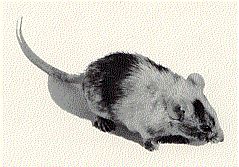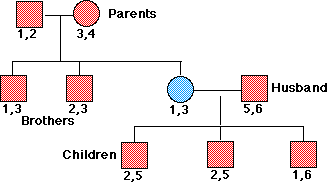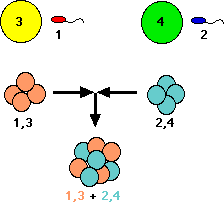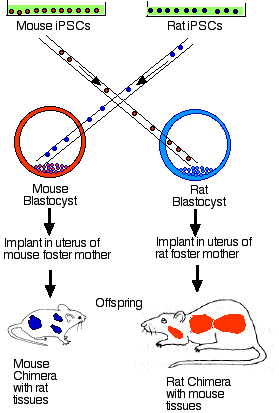Genetic Mosaics
A genetic mosaic is a creature whose body is built of a mixture of cells of two or more different genotypes.
In mammals they arise by several different mechanisms:
- The fusion of two different zygotes, or early embryos, into one. (The reverse of the process that produces identical twins!) The resulting animal is called a chimera (after the monster in Greek mythology with a lion's head, goat's body, and serpent's tail). The tetraparental mouse is a chimera formed this way. But on rare occasions, the same process can occur spontaneously in humans (especially those using in vitro fertilization).
- The sharing of blood supplies by separate embryos. This occurs with the occasional fraternal cattle twins and also — less often — with human fraternal twins who have shared the same placenta. Blood stem cells of each twin seed the bone marrow of the other. Only their blood cells are mosaic.
- During early development, errors during mitosis can produce stem cells that go on to populate a tissue or organ with, for example, a chromosomal aberration (e.g., aneuploid).
Example: Occasionally a baby is born with blood cells that have three copies of chromosome 21 (the same set responsible for Down syndrome). This can produce a leukemia-like illness that, fortunately, often disappears as that cell population declines.
- All female mammals are mosaic for the genes on the X chromosome because of the random inactivation of one or the other X chromosome in all their somatic cells. [Discussion]
- Anyone unlucky enough to have a cancer is a genetic mosaic because all cancers are made up of the descendants of cells carrying a suite of mutations not found in normal cells. [More]
- Recent advances have enabled the coding portions of the genome of single cells to be sequenced. Early results indicate than even normal cells in an adult have accumulated a suite of somatic mutations that differs from cell to cell. So all of us are genetic mosaics! However, the rate of somatic mutations in these normal cells is only a fourth of that in cancer cells.
As the name suggests, tetraparental mice have four parents: two fathers and two mothers (not including the foster mother that gives birth to them!).
This is how they are made:
- Early embryos at the 8-cell stage are removed from two different pregnant mice and placed in cell culture medium.
- Two different embryos are gently pushed together and, often, will
- fuse into a single embryo.
- After a period of further growth in culture, the fused embryo is implanted in a foster mother (whose uterus has been prepared for implantation by mating her with a vasectomized male).
- The mouse that is born is a chimera, all (usually) of whose organs are made of some cells derived from one pair of parents and some cells derived from the other pair.
 The photograph shows a tetraparental mouse derived from
The photograph shows a tetraparental mouse derived from
- a pair of inbred mice with black fur and
- a pair with white fur.
Note the intermingling of black and white patches.
(This mouse is not the same as an F1 hybrid produced by mating a white mouse with a black one. In that case, all the cells would be of the same genotype, and the coat would have been a uniform brown.)
The photograph (as well as the mouse) are courtesy of the late Dr. Thomas G. Wegmann.)
A report by Yu, et. al. in the May 16, 2002 issue of The New England Journal of Medicine documents the discovery of a tetragametic woman; that is a woman derived from four different gametes, not just two. She came to the doctors' attention because she needed a kidney transplant.
- Tissue typing, which is done with blood cells, showed her to have inherited the "1" HLA region of her father (who was 1,2) and the "3" region of her mother (who was 3,4).

- She had two brothers,
- one who inherited 1 from their father and 3 from their mother
- the other who inherited 2 from their father and 3 from their mother.
- Her husband typed 5,6
- Of her three sons,
- One was 1,6 which was to be expected, but
- the other two were both 2,5. The 5 they got from their father, but where did the 2 come from?
- The first thought was that she could not have been their mother, but clearly she knew better. (Paternity may sometimes be in doubt, but not maternity.)
- A clue came from typing other tissues. DNA analysis of her skin cells, hair follicles, thyroid cells, bladder cells, and cells scraped from inside her mouth revealed not only 1 and 3 but also 2 and 4. It is not clear why her bone marrow was an exception - containing only 1,3 stem cells.
How were these results possible?
The most reasonable explanation is that

- Her mother had simultaneously ovulated two eggs:
- one containing a chromosome 6 with HLA 3;
- the other with HLA 4.
- Her father would, of course, have produced equal numbers of 1-containing and 2-containing sperm.
- A 1-sperm fertilized the 3-egg
- A 2-sperm fertilized the 4-egg.
- Soon thereafter the resulting early embryos fused into a single embryo.
- As this embryo developed into a fetus, both types of cells participated in constructing her various organs including her oogonia (but not, apparently, the blood stem cells in her bone marrow).
Although she was a mosaic for the HLA (and other) genes on chromosome 6, all her cells were XX. So both the father's successful sperm cells had carried his X chromosome.
However, tetraparental humans have been found that were mosaic for sex chromosomes as well; that is, some of their cells were XX; the other XY. In some cases this mosaic pattern results in a hermaphrodite — a person with a mixture of male and female sex organs.
So what are her chances for finding a suitable kidney donor?
The HLA region on chromosome 6 carries a set of genes that encode the major transplantation antigens; that is, the antigens that trigger graft rejection.
Ordinarily, there is only a 1 in 4 chance that two siblings share the same transplantation antigens if both parents were heterozygous as in her case. [Link to explanatory diagram]
But because this woman has all four sets of transplantation antigens, she can accept a kidney from any one of her brothers as well as her mother (her father was dead) without fear of rejecting it.
Laboratory tests confirmed that she was unable to generate T cells able to react against the cells of either brother or her mother.
 In the 3 September 2010 issue of Cell, Kobayashi et al. report the creation of healthy rat-mouse chimeras:
In the 3 September 2010 issue of Cell, Kobayashi et al. report the creation of healthy rat-mouse chimeras:
- mice with functioning rat tissues and
- rats with functioning mouse tissues.
Their procedure:
- Generate induced pluripotent stem cells (iPSCs) from embryonic fibroblasts of each species. [Link to discussion of how this is done.]
- Inject:
- mouse iPSCs into rat blastocysts and
- rat iPSCs into mouse blastocysts.
- Implant these blastocysts into the uterus of pseudopregnant foster mothers of the same species as the blastocyst.
The Pdx-1−/− Mouse
Pdx-1 encodes a transcription factor that is essential for the development of the pancreas. Transgenic mice lacking a functioning Pdx-1 gene (Pdx-1−/−) die shortly after birth.
However, Kobayashi et al. found that injecting rat induced pluripotent stem cells (iPSCs) into mouse Pdx-1−/− blastocysts produced a few viable mouse chimeras complete with a pancreas made up almost exclusively of rat cells. The pancreas was fully functional producing both exocrine secretions (e.g., pancreatic amylase) and endocrine secretions (e.g., insulin, glucagon, and somatostatin).
23 October 2022

 The photograph shows a tetraparental mouse derived from
The photograph shows a tetraparental mouse derived from

 In the 3 September 2010 issue of Cell, Kobayashi et al. report the creation of healthy rat-mouse chimeras:
In the 3 September 2010 issue of Cell, Kobayashi et al. report the creation of healthy rat-mouse chimeras: